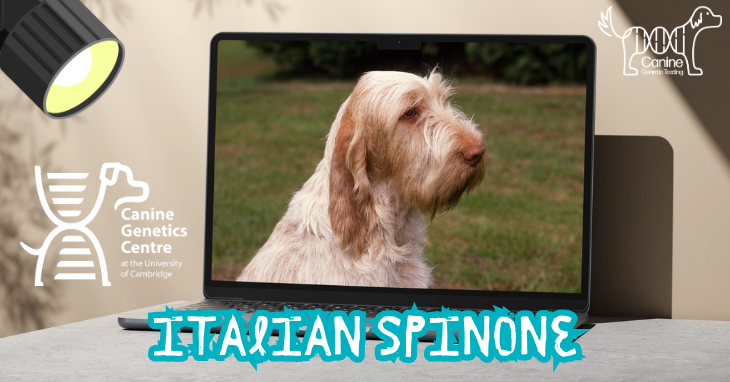
This is the second in our series of ‘Spotlight’ articles where we focus on a breed that the Canine Genetics Centre (CGC) has worked closely with over many years to investigate the inheritance of disorders that represent a challenge to their health. This time we describe our work with the Italian Spinone breed community to understand the underlying genetics of two devastating diseases, one of which has now had a DNA test available for over 15 years that has been successfully used to reduce the number of affected dogs born with this debilitating disease.
The story starts with this disease – a progressive neurological condition called spinocerebellar ataxia (CA) that manifests in puppyhood with a rapid decline in the dog’s health resulting in euthanasia typically by 1 year old. This disease was first described in the literature in 1996 by neurologists Claire Rusbridge and Simon Wheeler and in 2005, with funds raised by the Italian Spinone Club of Great Britain (ISCGB), the Spinone Club of America, and donations from individuals, CGC researchers at the Animal Health Trust (AHT) were able to start investigating the genetics of the condition with an aim to develop a preventive DNA test.
 The research would not have been made possible without the tireless efforts of Pat Wilkinson, a Spinone breeder who at that time was the ISCGB CA co-ordinator. Without her dedication and tireless hard work to collect DNA samples the journey would have been much longer and more difficult. Credit must also go to the Italian Spinone community who pulled together to run all sorts of events to raise the funds for the CA research.
The research would not have been made possible without the tireless efforts of Pat Wilkinson, a Spinone breeder who at that time was the ISCGB CA co-ordinator. Without her dedication and tireless hard work to collect DNA samples the journey would have been much longer and more difficult. Credit must also go to the Italian Spinone community who pulled together to run all sorts of events to raise the funds for the CA research.
Following further characterisation of the disease by veterinary neurology specialists at the AHT and with the availability of DNA samples from family members of affected dogs, the CGC carried out a genetic mapping study using 60 dogs that linked the condition to a region on canine chromosome 20. Definition of the affected haplotype subsequently enabled a linkage-based DNA test to be developed in 2008, and in 2009 the AHT team of scientists were awarded the inaugural Companion Animal Welfare Award, from the Universities Federation for Animal Welfare (UFAW), in recognition of significant innovations or advances for the welfare of companion animals. The mutation was later identified as a repeat expansion of three DNA bases, GAA, within a non-coding part of the ITPR1 gene, variants in which have been shown to be associated with SCA in humans. Collaborative work with a veterinary neuropathologist validated these findings, which were published in the journal Mammalian Genome in 2014 (PMID: 25354648). Since its launch, several hundred Spinone have been screened for CA in the UK and internationally.
In parallel, starting in 2013 and continuing to be funded by the Italian Spinone Club of Great Britain Health Fund, a study of idiopathic epilepsy began starting with a questionnaire-based survey of Italian Spinone in the UK. This was conducted by veterinary neurologists and epidemiologists at the Animal Health Trust. This study found a high prevalence of the disease in the UK breed population and provided detailed information on the clinical characterisation of the disease and its treatment and prognosis.
 These findings fed into the subsequent genetic analyses that began in 2014 with the collection of DNA samples from well-defined cases and from dogs over 7 years old unaffected by the disease. This research is ongoing and continues now 10 years later! This is because, by contrast to the SCA described above that is caused by a single gene mutation, inheritance of idiopathic epilepsy in the Spinone is complex and genetic investigation therefore requires larger sample numbers and more intricate and longer running studies to tease out reproducible risk variants. Sally Ricketts who leads this research says “Idiopathic epilepsy is challenging to study with traditional genome-scanning (genome-wide association study) approaches, but we are now investigating the genetics of idiopathic epilepsy through whole genome sequencing of robust cases, with the aim of building up a resource of data that we can investigate using various computational approaches to search for both rare and common risk variants. In time, with the collection of further DNA samples, we hope that validating these variants across and within breeds will improve our knowledge of how genetics is involved in the development of this debilitating disease.” We have also started working with the Italian Spinone Club of America that have recently donated some funds to support our work going forwards. The breed is also very proactive and banks buccal swab samples from litters born in the UK for storage for future research into epilepsy and any other conditions that may emerge.
These findings fed into the subsequent genetic analyses that began in 2014 with the collection of DNA samples from well-defined cases and from dogs over 7 years old unaffected by the disease. This research is ongoing and continues now 10 years later! This is because, by contrast to the SCA described above that is caused by a single gene mutation, inheritance of idiopathic epilepsy in the Spinone is complex and genetic investigation therefore requires larger sample numbers and more intricate and longer running studies to tease out reproducible risk variants. Sally Ricketts who leads this research says “Idiopathic epilepsy is challenging to study with traditional genome-scanning (genome-wide association study) approaches, but we are now investigating the genetics of idiopathic epilepsy through whole genome sequencing of robust cases, with the aim of building up a resource of data that we can investigate using various computational approaches to search for both rare and common risk variants. In time, with the collection of further DNA samples, we hope that validating these variants across and within breeds will improve our knowledge of how genetics is involved in the development of this debilitating disease.” We have also started working with the Italian Spinone Club of America that have recently donated some funds to support our work going forwards. The breed is also very proactive and banks buccal swab samples from litters born in the UK for storage for future research into epilepsy and any other conditions that may emerge.

“I have worked with many breeds during my career, but the people who own, breed and love Italian Spinone stand out. Since we first started to investigate the genetics of CA in 2005, the breed community has worked tirelessly to not only raise funds to help support our research, but also to make sure the right DNA samples are collected and submitted to the CGC. This extraordinary engagement made the difference when it came to developing a DNA test for CA and is again proving instrumental in our efforts to tease apart the genetics of idiopathic epilepsy in this lovely breed. My personal thanks go to Pat Wilkinson, for her outstanding dedication to the CA research, and Elaine Kirkham, the current Breed Health Co-ordinator, for her enduring support of the Canine Genetics Centre and our efforts to improve the genetic health of this lovely breed.“
Canine Genetic Testing are currently offering a 20% discount on the CA test until the end of the month, and will then be launching a Crufts special of 25% discount from the beginning of February on all of their in-house tests.


